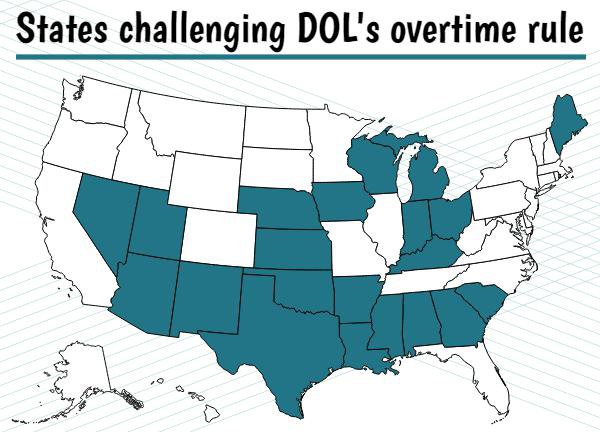Twenty-one states and several employer interest groups filed lawsuits against the U.S. Department of Labor (DOL) September 20, alleging that the agency’s new overtime regulations exceed its authority.
For a Limited Time receive a
FREE Compensation Market Analysis Report! Find out how much you should be paying to attract and retain the best applicants and employees, with
customized information for your industry, location, and job.
Get Your Report Now!
HR Daily Advisor
FLSA survey
Are your workplace policies and practices ready for the new DOL overtime regs? Let's find out! Participate in the new FLSA Survey today!
Click here to get started.
|
The suits, however, are not expected to have any success in the near future and employers would be well-served to be in compliance by the December 1 deadline, according to one expert.
Background
DOL issued new regulations earlier this year more than doubling the salary threshold for employees eligible for overtime. Come December, employees earning less than $913 per week (which amounts to $47,476 annually) must be classified as nonexempt from the Fair Labor Standards Act’s (FLSA) overtime requirements, regardless of whether they meet any of the law’s duties tests.
 The lawsuits (States of Nevada, et al. v. U.S. Department of Labor, No. 1:16-cv-00407 (E.D. Texas) and Plano Chamber of Commerce v. Thomas E. Perez, No. 4:16-cv-00732 (E.D. Texas)) allege that DOL went too far in several respects.
The lawsuits (States of Nevada, et al. v. U.S. Department of Labor, No. 1:16-cv-00407 (E.D. Texas) and Plano Chamber of Commerce v. Thomas E. Perez, No. 4:16-cv-00732 (E.D. Texas)) allege that DOL went too far in several respects.
First, the complaints allege that DOL’s use of the salary threshold as the main test for overtime eligibility ignores the importance that the FLSA places on an employee’s duties. The emphasis on salary “defies the statutory text … Congressional intent, and common sense,” the states’ complaint says.
Moreover, the rule’s automatic increase—which brings the threshold to $51,000 by 2020—runs afoul of federal law requiring that regulations go through notice and comment procedures, the lawsuits claim. Both point to DOL’s previous position in its 2004 rules updating the salary threshold that indexing is prohibited absent specific Congressional authorization; “Invalid action does not become valid through the passage of time,” the first suit said.
The states, making these arguments as employers themselves, also alleged that the regulation violates the U.S. Constitution. Enforcing the rule against states “infringes upon state sovereignty and federalism by dictating the wages that States must pay to those whom they employ in order to carry out their governmental functions, what hours those persons will work, and what compensation will be provided where these employees may be called upon to work overtime,” they said.
Some states offered estimates of how the rule would affect them. Arkansas, for example, noted that 3,995 state employees will be newly eligible for overtime, creating overtime costs that would “far exceed” a million dollars. Arizona estimated that if it raised the salary of its 1,437 affected employees, it would cost the state $10 million. “Left unchecked, DOL’s salary basis test and compensation levels will wreck State budgets,” they said.
In response to the complaints, DOL said it is confident in the legality of the rule. Secretary of Labor Thomas E. Perez said in a statement that these “partisan lawsuits” are obstructionist tactics aimed at preventing the department from ensuring that middle-class workers receive fair pay.
A chance for change?
While the plaintiffs probably chose to file their suits in the U.S. District Court for the Eastern District of Texas because it is known as a “rocket docket” where complaints proceed to trial quickly, that’s not indicative of any potential victory, according to William E. Hammel, a partner in Constangy, Brooks, Smith & Prophete LLP’s Dallas office.
The states’ argument that there is no basis for a salary threshold at all has little chance of success, he told HR.BLR.com®. “The automatic increase [claim] may result in a few interesting appellate issues,” he said, but even a stay of that provision wouldn’t affect the changes coming on December 1. Ultimately, these rules aren’t going away, Hammel said.
The National Federation of Independent Business (NFIB), one of the plaintiffs in the second complaint, also is pursuing other avenues, including a recent request that DOL delay the rule’s effective date for small businesses. “We’re working with Congress on a bipartisan solution. We are challenging the regulation in court. We are also trying to prevail on the Department of Labor for a more realistic timeframe,” said NFIB President and CEO Juanita Duggan in a statement. “[W]e’re fighting on every front to minimize the damage.”
Lawmakers also have made several attempts to curtail the rule through legislation, but experts say President Obama would veto any bills that make it through Congress.
Employer takeaway
Hammel said the states are probably right in their predictions: employers’ payrolls will be substantially affected and implementation of the rule may result in significant layoffs, especially for government employees.
But that doesn’t mean the lawsuits will succeed in delaying or stopping the rules. Employers should not delay compliance, Hammel said. “Expect these rules to go into effect.” There is a cottage industry of plaintiffs’ attorneys that seek out wage and hour claims, he added, “and they have their lawsuits planned out.”
For implementation information and options for controlling overtime costs, see New overtime regulations require $47,476 salary for exemption.
The map below showcases all 21 states that are included in the lawsuit against the DOL.

|
 Kate McGovern Tornone is an editor at BLR. She has almost 10 years’ experience covering a variety of employment law topics and currently writes for HR.ComplianceExpert.com and HR.BLR.com. Before coming to BLR, she served as editor of Thompson Information Services’ ADA and FLSA publications, co-authored the Guide to the ADA Amendments Act, and published several special reports. She graduated from The Catholic University of America in Washington, D.C., with a B.A. in media studies. Kate McGovern Tornone is an editor at BLR. She has almost 10 years’ experience covering a variety of employment law topics and currently writes for HR.ComplianceExpert.com and HR.BLR.com. Before coming to BLR, she served as editor of Thompson Information Services’ ADA and FLSA publications, co-authored the Guide to the ADA Amendments Act, and published several special reports. She graduated from The Catholic University of America in Washington, D.C., with a B.A. in media studies.
|